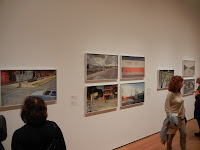The following photographers have been included in the show, with the number of works on view and image details in parentheses:
- Moyra Davey (2 works, consisting of grids of 25 and 16 c-prints respectively, unframed and pinned directly to the wall, from 2010-2011)
- George Georgiou (8 pigmented inkjet prints, framed in white and unmatted, from 2006-2007)
- Deana Lawson (7 pigmented inkjet prints, framed in white and unmatted, from 2007-2010)
- Doug Rickard (8 pigmented inkjet prints, framed in white and unmatted, from 2009-2011)
- Viviane Sassen (8 pigmented inkjet prints, variously framed and unmatted, various sizes, from 2006-2010)
- Zhang Dali (20 gelatin silver prints, with photomechanical reproductions and type written text, framed in white and matted, from 2003-2011)
 Comments/Context: There's a little bit of everything in this year's New Photography exhibit at the MoMA, making it much broader and more inclusive than other recent incarnations of this annual survey. Rather than highlighting a particular theme or grouping similar/contrasting approaches, this show runs the gamut from documentary to digital appropriation, with relatively equal measures of conceptual and straight photography, offering us diversity and divergence as opposed to a particular institutional point of view. The implication is that the medium is expanding and extending in so many directions that it's impossible to use any one narrow definition anymore, and there's quality and innovation to be found in a plethora of styles and working methods.
Comments/Context: There's a little bit of everything in this year's New Photography exhibit at the MoMA, making it much broader and more inclusive than other recent incarnations of this annual survey. Rather than highlighting a particular theme or grouping similar/contrasting approaches, this show runs the gamut from documentary to digital appropriation, with relatively equal measures of conceptual and straight photography, offering us diversity and divergence as opposed to a particular institutional point of view. The implication is that the medium is expanding and extending in so many directions that it's impossible to use any one narrow definition anymore, and there's quality and innovation to be found in a plethora of styles and working methods.In terms of sheer visual elegance, Viviane Sassen's photographs are far and away the most successful. Her pictures have a perplexing, mesmerizing magic, where simple forms and odd compositional angles create an atmosphere of the unexpected. Orange soda is poured into a hole in the sidewalk, a boy lies tipped over in a blue plastic chair, a paper bursts into flames in front of a subject's face, and a woman's body lies draped in a light blue sheet. Seemingly normal subjects take on an air of confusing mystery, and decoding some kind of plausible narrative becomes tricky, pushing the viewer back into an exploration of the lines, color, and space of the formal elements of the pictures. The enigmatic, unknowable secrets of the images give them a power that goes far beyond their straightforward appearance.
I think the opposite wall pairing of Doug Rickard and Zhang Dali was an inspired connection of related ideas, where elusive photographic truth and power-driven propaganda mix with surveillance, privacy, and the omniscience of the digital Internet. Rickard's photographs are full of thorny conceptual questions, from how they were made (appropriated from Google Street View and then selected/cropped/reframed) to what they might represent (the digital embodiment of "everything", the intrusion on the edges of personal freedoms, and the details of suburban decline which they so clearly document). All of the works look downward from the all-seeing robot cameras, finding a depressing array of rusting cars, muddy lots, wayward youths, and poverty stricken streets, unvarnished and exposed to the eyes of the Internet. Zhang's pictures are proof positive of deliberate photographic censorship and alteration in a more political sense, where history and collective memory get changed by airbrushing out undesirables. Photo ops of Chairman Mao are retouched and enhanced, simplifying the visual story, collaging together separate parts, or cropping out distractions to get to a new kind of truth. Both sets of work consider the nature of documentatio, manipulation and archival memory, and standing between them, the resonance of interchangeable ideas is very strong.
.
The remaining works by Moyra Davey, Deana Lawson, and George Georgiou are all accomplished in their own ways (although slightly less exciting to my eye/brain), ranging from voyeuristic portraiture to documentary photography capturing the dichotomies of old/new, returning all the way back to a pleasingly retro, analog dip into the tangible. Davey's intellectual taxonomies of bare bulb light fixtures and book bindings/empty coffee cups are much better in grid form than in the long around-the-room hang of her last gallery show; the visual echoes and repeated patterns of tape are much more apparent.
All in, this show has a something-for-everyone safety that makes it approachable, while still educating viewers about the complex heterogeneity of the contemporary photographic world. In the future, I think this incarnation of the New Photography series will be remembered as a coming out party for Viviane Sassen, and as a further validation of the artistic white space created by Internet driven digital imagery, as embodied by the work of Doug Rickard.
Collector's POV: Given this is a museum show, there are of course no prices. The photographers in the show are represented by the following galleries:
- Moyra Davey: Murray Guy (here)
- George Georgiou: unknown
- Deana Lawson: unknown
- Doug Rickard: Yossi Milo (here)
- Viviane Sassen: Motive (here), Stevenson (here)
- Zhang Dali: Eli Klein (here)
Rating: * (one star) GOOD (rating system described here)
Transit Hub:
- Exhibition site (here)
- Reviews: NY Times (here), New Yorker (here), Time LightBox (here), PhotoBooth (here)
- George Georgiou artist site (here)
- Deana Lawson artist site (here)
- Doug Rickard artist site (here)
- Viviane Sassen artist site (here)
Through January 16th
Museum of Modern Art
11 West 53rd Street
New York, NY 10019





No comments:
Post a Comment